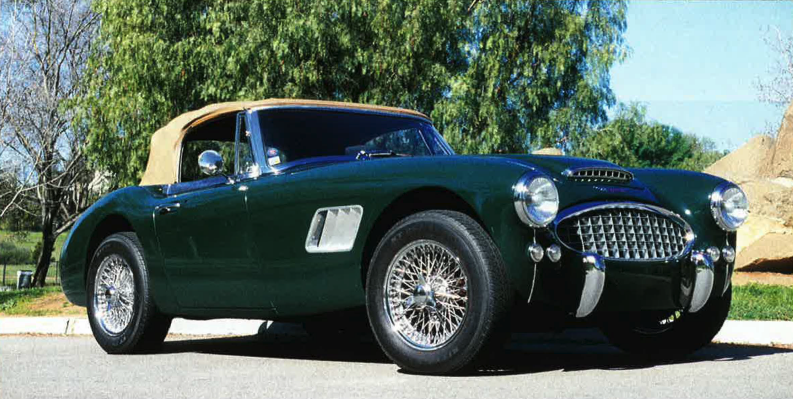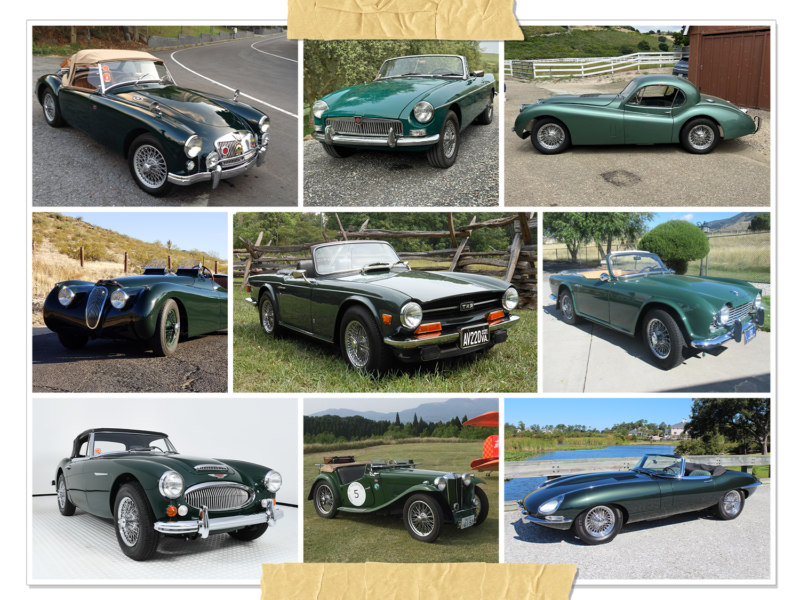By Alan Paradise
As the ignition key is inserted into its designated position, the anticipation builds. The ignition is activated and the gas pedal is gently depressed. The starter spins the heavy flywheel, which, in turn, begins the process for internal combustion. The pistons pump volatile vapor and burned gases. Then, it happens—the wonderful sound of exhaust exiting through muffler and tailpipe—the distinctive and sweet melody that comes from a Big Healey.
The road that would allow so many diehard enthusiasts to have this pleasure began in 1953. Donald Healey brought to market a sports car that has proven to have timeless beauty and lasting mechanical ability. The first of the true smooth-lined British roadsters, the early 100 series were stout two-seaters with practical overtones. Ahead of its time and competition, the BN1 was an immediate hit in Europe. It had all the styling of more expensive British, German, Italian, and American sports cars, but offered more usable power as well as being more affordable.
The car was a bit less well received in the U.S., mainly due to the low gearing. However, the BN2 model would solve that problem, as Healey added a Laycock overdrive unit to the manual gearbox. The minimal ground clearance proved to be both a positive and negative for some markets, depending on road conditions within a geographical location. What couldn’t be solved was the heat transference from the engine compartment to the interior. This, along with body deterioration, remain the two biggest concerns for Healey hunters.
Austin-Healey popularity in America accelerated in 1956 with the release of the 100-6. In 1958, the longer wheelbase allowed buyers an option of having a two-seat or four-seat roadster. A larger 2.6L engine added 12 more horsepower, bringing the number to 102. By late 1957, a new cylinder head design helped push horsepower to 117. A redesigned oval grille and small air intake on the hood provided a muscled-up appearance, an ideal hook for marketing to American buyers.
In the middle of the successful 100-6 manufacturing, Austin-Healey birthed a car that would become one of history’s mile-marker vehicles…the Sprite. The idea was to make a very affordable, simple to build and maintain two-seater. In 1958, the first of 38,999 Sprite Mk Is came off the assembly line. The car was an enormous success. However, irony played a part in the history of the car. The most endearing feature of this simple sports car is the headlights. Affectionately known in the U.S. as the “bugeye,” the position of the headlights was determined not by styling, but by budget. The original Sprite Mk I design called for hidden headlights that rotated into position. This idea was abandoned to save costs—thus the headlights were perched on the hood.
One of the many charms of the Sprite Mk I is that it remains a capable car. In full factory equipment, the 43 horsepower engine is not powerful enough to get even the most inexperienced driver in trouble. However, with the large number of performance parts available, a tuned-up Sprite can break the 100 mph mark.
MG performed assembly for all Sprites at the famous Abingdon facility. This leaves little wonder why later Sprites and Midgets were so closely related.
As sales of the Sprite Mk I were at full throttle, Austin-Healey developed the final version of the Big Healey. The 3000 utilized the same basic layout as the 100-6, but the engine capacity was greater. In its most powerful form, the 3000 produced 148 horsepower, and was capable of much more. It is the promise of more horsepower and torque that continues to make the 3000 such a desirable classic roadster.
To mate with the additional power, Austin-Healey also added other refinements and upgrades to the 3000. The 1959-61 models featured a folding top. Beginning in 1962 and running to the last 3000 in 1968, there were a number of upgrades, which included roll-down windows, more power, and a restyled wood-covered dash. By 1964, the rear suspension was more sophisticated with radius arms and an improved axle location.
The final Big Healeys, in showroom form, were capable of speeds in excess of 120 mph. Impending EPA and DOT regulations put an end to importation of Donald Healey’s two-seater. He would later return with the Jensen-Healey, but that’s a horse of another color…and another issue. Over the life term of all the Big Healeys, about 80% of production was sent to the United States.
In terms of sales success, the decade-long run of the second generation Sprite was Austin-Healey’s claim to fame. From 1961 to 1971, over 80,000 Mk II, III, and IV models were produced. Along the road many refinements were made. Most notable were the 1964 change from quarter to half-elliptic rear springing, as well as roll-up windows. The tilt-front fender/hood assembly gave way to a conventional pop hood in 1961.
Perhaps the most desirable of all the second generation Sprites is the 1967 model. This incorporated all the charm of basic British sportscar styling without the EPA or DOT intrusions languished on the 1968-71 Sprites and carrying over onto the MG Midgets.
Because production of U.S. spec MG Midgets continued until 1979, parts and service for Sprites remains easy to find and very affordable. For younger enthusiasts looking to perform their first restoration, the Sprite is an ideal selection.
Throughout the years, one of the most compelling factors that have kept the Healey in fashion is that it can be considered the British hot rod. This became an important image for American buyers. It helped propel the popularity of big Healeys through the late 1960s and into the early 1980s. Since that time, restoration has become more celebrated. However, the foundation for many Healey enthusiasts was formed decades ago from modified versions. Today, while Healey clubs do not enjoy the membership numbers like MG, Triumph, and Jaguar clubs, their members are just as enthusiastic and loyal.











'Austin-Healey: The Other British Classic' has no comments
Be the first to comment this post!